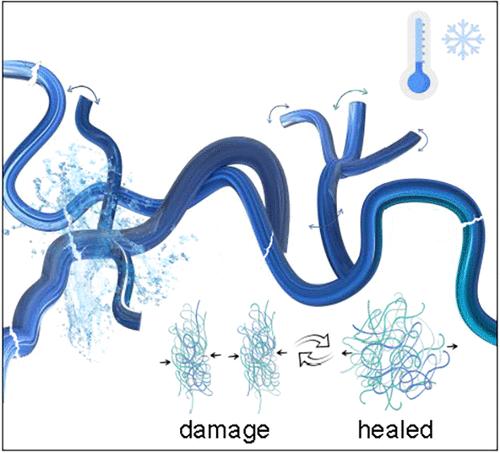聚合物在低温/室温下实现自愈的要求
IF 5.2
1区 化学
Q1 POLYMER SCIENCE
引用次数: 0
摘要
低温自愈聚合物是至关重要的,因为许多现实世界的损伤事件发生在外部加热不切实际或能源效率低下的环境中。然而,由于聚合物链迁移率的限制,在这些温度下实现有效的自修复仍然是一个重大挑战。为了应对这一挑战,研究人员研究了一些策略,例如调节可逆化学键的强度;然而,仅靠这些方法往往是不够的。在这方面,我们综合考察了影响低温和环境温度下聚合物链迁移率的因素。我们专注于优化材料设计,以平衡机械强度和愈合性能,考虑诸如低玻璃化转变温度的聚合物,不同类型的聚合物,支链到超支化结构,形状记忆效应的作用以及溶剂的促进影响等因素。这些见解为设计适合特定应用需求的自修复聚合物提供了基础。此外,我们概述了合成设计、分子迁移率、愈合时间、机械性能和其他功能特性(如疏水性和阻抗模量)方面的关键考虑因素,以及创造在低温或室温下有效自愈的材料的前景。本文章由计算机程序翻译,如有差异,请以英文原文为准。

Requirements for Achieving Self-Healing at Low/Room Temperature in Polymers
Low-temperature self-healing polymers are crucial, as many real-world damage events occur in environments where external heating is impractical or energy-inefficient. However, achieving effective self-healing at these temperatures remains a significant challenge due to the restricted polymer chain mobility. To tackle this challenge, strategies have been investigated, such as modulating the strength of reversible chemical bonds; however, these approaches alone are often inadequate. In this Perspective, we comprehensively examine the factors influencing polymer chain mobility under low and ambient temperatures. We focus on optimizing material design to balance mechanical strength and healing performance, considering factors such as polymers with low glass transition temperatures, different types of polymers, branched to hyperbranched architectures, the role of shape-memory effects, and the facilitative impact of solvents. These insights provide a foundation for designing self-healing polymers tailored to specific application demands. Furthermore, we outline key considerations in synthetic design, molecular mobility, healing time, mechanical properties, and other functional properties, such as hydrophobicity and impedance modulus, as well as perspectives for creating materials that effectively self-heal at low or room temperatures.
求助全文
通过发布文献求助,成功后即可免费获取论文全文。
去求助
来源期刊

Macromolecules
工程技术-高分子科学
CiteScore
9.30
自引率
16.40%
发文量
942
审稿时长
2 months
期刊介绍:
Macromolecules publishes original, fundamental, and impactful research on all aspects of polymer science. Topics of interest include synthesis (e.g., controlled polymerizations, polymerization catalysis, post polymerization modification, new monomer structures and polymer architectures, and polymerization mechanisms/kinetics analysis); phase behavior, thermodynamics, dynamic, and ordering/disordering phenomena (e.g., self-assembly, gelation, crystallization, solution/melt/solid-state characteristics); structure and properties (e.g., mechanical and rheological properties, surface/interfacial characteristics, electronic and transport properties); new state of the art characterization (e.g., spectroscopy, scattering, microscopy, rheology), simulation (e.g., Monte Carlo, molecular dynamics, multi-scale/coarse-grained modeling), and theoretical methods. Renewable/sustainable polymers, polymer networks, responsive polymers, electro-, magneto- and opto-active macromolecules, inorganic polymers, charge-transporting polymers (ion-containing, semiconducting, and conducting), nanostructured polymers, and polymer composites are also of interest. Typical papers published in Macromolecules showcase important and innovative concepts, experimental methods/observations, and theoretical/computational approaches that demonstrate a fundamental advance in the understanding of polymers.
 求助内容:
求助内容: 应助结果提醒方式:
应助结果提醒方式:


